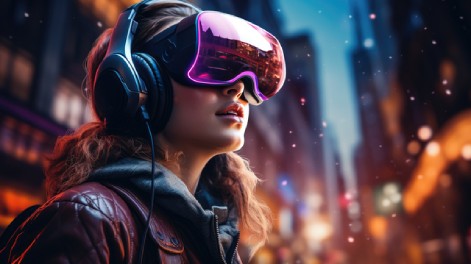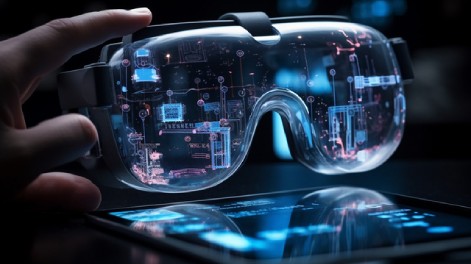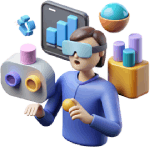
Virtual Reality (VR)
Virtual reality offers a fully immersive, computer-generated environment where users can interact with their surroundings through headsets and sometimes even additional controllers. It creates an experience where the user feels "inside" the virtual world. In education, VR allows students to explore simulations like virtual labs or historical events that they wouldn’t typically experience in a classroom. Corporate training programs also use VR to create realistic environments for practicing complex or dangerous tasks, providing a safe space for learning without the real-world consequences.

Augmented Reality (AR)
AR differs from a VR environment in that it imposes additional digital content onto the existing sight to be perceived from the real world through eyeballs; thus, persons with AR glasses, or smartphones alike, interact with the physical world along with virtual objects simultaneously. For the classroom, textbooks come to life whereas students are looking at 3D interactive models on intricate concept-related matters. From a corporate training perspective, on-the-job training becomes interesting with AR so that it presents relevant information on the fly to tackle the problem better.
Mixed Reality (MR)

Mixed reality combines the best of VR and AR: the interactions between digital content and the real world need to happen in real time. MR environments allow users to change or manipulate both real and virtual objects. Students can, for instance, study anatomy by interacting with 3D holograms of the human body, while workers practice some complex machinery repair with assistance from an MR system that is focused upon their specific context. This peculiar mixture is valuable indeed for a few industries such as medicine, engineering, and architecture, where precision and the interaction with physical objects are paramount.
360° Video

While VR immerses users in a fully interactive computer-generated world, 360° video offers a more passive yet intriguing engagement by filming a scene in all directions. Viewers can gaze upon the scene and explore the environment as if they were actually present there, whereas VR offers a more active experience. Thus, 360° videos are usually employed for virtual tours that create the illusion of the user standing at some remote or inaccessible places, such as ancient ruins, museums, or remote laboratories.
Hence, 360° video becomes a good tool for educational purposes since it lets students experience historical or scientific environments while remaining in the classroom. For corporate training, 360° video offers a unique advantage by introducing real-life situations from many angles to allow employees to perceive from diverse points of view. Such immersive learning strengthens decision-making and problem-solving skills by allowing workers to engage in complex situations and responses in a safe, virtual environment.
How These Tools Are Transforming Education and Training
VR, AR, MR, and 360° video are beginning to rupture once the established educational and corporate training culture. These immersion tools present a somewhat engaging, practical, and accessible way of learning.
In Corporate Training
These represent breakthroughs in the methods of employee training within corporate settings. The employees can put their learning into actual practice, via VR simulation, in complete risk-free surroundings. It is especially helpful in industries such as healthcare, where practitioner-level doctors can practice surgical procedures or emergency-response scenarios. AR helps workers in real time by providing them with information or instructions that are crucial while in no way disrupting their workflows.
In Education
A bundle of joy came into the world with the new technology of creating interactive environments to carry learning a step further, leaving realized lessons. Imagine experiencing ancient civilizations through VR or learning code through AR-the possibilities are endless for a tech-assisted translation of the usual textbooks and lectures. Thus, a new dimension is added to the learning experience as students interact with sight, sound, and touch; it is useful, especially for those who learn by doing. This interaction keeps students still entertained and excited about their journey, lessening the monotony of learning and attaining an aura of an adventurous trip.
In Upskilling
Upskilling, a key requirement in this era of unprecedented technological change, is always in demand. VR, AR, and MR contribute to upgrading a person's skill set. These tools provide interactive real-time feedback and personalized learning environments, which are the best ways for individuals to stay ahead of the alterations in the job market. Learning through immersive tools had made the process easy to learn new software or soft skills like communication and leadership.
Final Thoughts
Unleashing VR, AR, MR, and 360° Video into the educational, corporate training, and upskill space is essentially changing how people interact with content, learn new skills, or even prepare for the future. They are standing for more effective and adventurous ways of imparting knowledge between the mediums of imparting an abstract concept, while these were the mediums. These technologies make education fun, immersive, and practical. Another innovative application may arise soon from this evolution that will bridge a gap between pure theory and application for helping every learner to have something in hand for a much better world in the present age.
👁️ One glance. One world opens. Experience a first-person perspective as you enter the metaverse through VR or browser. pic.twitter.com/dS1oi3K2YA
— PynoLand (@PynoLand) June 24, 2025